 |
THE GREATEST ?PEAK ?OF THEM ALL
Awakening before dawn, porridge for breakfast, checking out and off you go. Once again: descent, ascent, breathlessness, pain in knee joints, a heavy backpack straining your shoulders, crackers and tea for snacks, a couple of hours walk to reach a village visible at a distance, shower, dinner and sleep. With every step and every metre, the list of priorities in life shortens to the vitally essential minimum – food, water, a warm blanket and a Nikon D70 – simply survival.
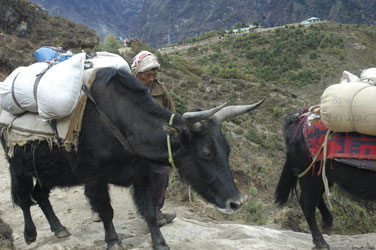 A mere half-century ago, the route leading up to Everest would begin at Kathmandu, capital of Nepal. Rows of Sherpa porters and mules would tread along through the jungle and paddy fields. Ironically, one would have to toil and sweat before reaching the eternal snows. As time went by, the Himalayas became so highly in demand that they brought forth a 184-kilometre-long road and the world's most dangerous airport in the village of Lukla, with a short runway squeezed in between an abyss on one side and a mountain slope on the other. These two have shortened the journey to the Khumbu valley, which is adjacent to Everest's southern foot and gives its name to one of the three regions inhabited by the Sherpa ethnicity, by two weeks.
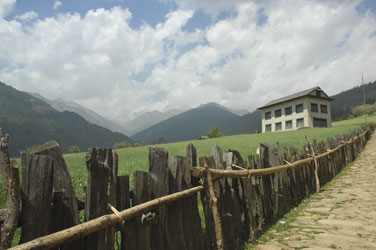 Today, very few wish to follow in the steps of the first expeditions, and their journey boils down to the reaching the elevations of Kala Patthar and Gokyo Ri, from where opens a magnificent view of Mount Everest. Some come (and I mean literally, too) to a compromise when they begin their trek in the village of Jiri, the final destination of the road from Kathmandu, joining the more adventurous enthusiasts at Lukla airport in a week's time.
The heights do not spare those venturing on a week's trudge. Worn-out trekkers curse the day they decided to stretch their legs and glance upon village life in all its immutability. Every ascent is followed by an imminent descent and, in the evening, they contemplate the dead ringer for the summit they are standing upon, just across, which they will climb up the entire next day – well, as soon as they clamber down this very one. The trekkers disparage the Nepalese who form paths in contravention of both the landscape's peculiarities and common sense; their eyes well up in tears, for they find themselves only half-way through the route, having conquered a great deal of similar hills.
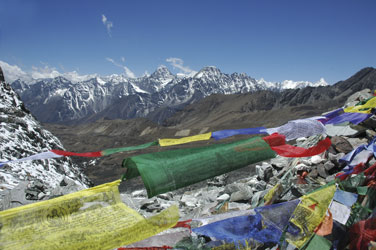 Around them, village life carries on, in the same way as two centuries ago: there are peasants, pilgrims, monks and caravans of pack animals; there is harvesting, kindling the stove and shooting the breeze in low voices over cups of tea. Chickens bask in the beams of the setting sun, and donkeys shift from hoof to hoof in the shade of banana trees. But where are the welcoming "Namaste!"1 sing-sung by friendly passers-by? Where are the shy peasants and shepherds? Where are the hearty portions of noodles and free lodging? They have all been left in the past. The reality is flashy with expensive guesthouses, multitudes of people obscuring snow-capped views and hosts cooking the Nepalese dish of dal bhat from rice, vegetable curry and beans for 20 people, too busy to engage in conversation. Noticing a foreigner, local kids start begging for money and otherwise kind highlanders turn into cynical hucksters. Here, everything becomes as straightforward as Western mentalities: go higher and further, the rest is the chagrin of delay!
 If initially your rush for time offers very few impressions, starting from 2,000 metres above sea level, high-altitude sickness kicks in. In the local ailment contest, it is second only to knee pain. Caused by oxygen insufficiency, it is characterised by migraines, fatigue and insomnia. With scanty acclimating, it may cause cerebral or pulmonary oedema, which could be lethal. This is why it is advised to gain height gradually, drink at least four litres of fluids a day, sleep at altitudes lower than those reached during the day, and, if your condition worsens, descend and rest.
A typical guesthouse is panic personified. Every day, Sherpa bring down tourists, livid and bloody, to Lukla, and choppers fly regularly to the zone of rarefied air. Nervous trekkers drink lemon tea from thermoses, eat garlic soup and pray that this cup passes from them. One of my acquaintances once shooting the breeze in low voices over cups of tea. Chickens bask in the beams of the setting sun, and donkeys shift from hoof to hoof in the shade of banana trees. But where are the welcoming "Namaste!" sing-sung by friendly passers-by? Where are the shy peasants and shepherds? Where are the hearty portions of noodles and free lodging? They have all been left in the past. The reality is flashy with expensive guesthouses, multitudes of people obscuring snow-capped views and hosts cooking the Nepalese dish of dal bhat from rice, vegetable curry and beans for 20 people, too busy to engage in conversation. Noticing a foreigner, local kids start begging for money and otherwise kind highlanders turn into cynical hucksters. Here, everything becomes as straightforward as Western mentalities: go higher and further, the rest is the chagrin of delay!
If initially your rush for time offers very few impressions, starting from 2,000 metres above sea level, high-altitude sickness kicks in. In the local ailment contest, it is second only to knee pain. Caused by oxygen insufficiency, it is characterised by migraines, fatigue and insomnia. With scanty acclimating, it may cause cerebral or pulmonary oedema, which could be lethal. This is why it is advised to gain height gradually, drink at least four litres of fluids a day, sleep at altitudes lower than those reached during the day, and, if your condition worsens, descend and rest.
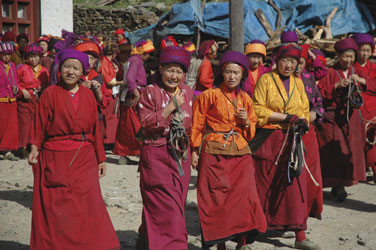 A typical guesthouse is panic personified. Every day, Sherpa bring down tourists, livid and bloody, to Lukla, and choppers fly regularly to the zone of rarefied air. Nervous trekkers drink lemon tea from thermoses, eat garlic soup and pray that this cup passes from them. One of my acquaintances once took nine litres of water within same day, trying to keep his mountain migraine at bay, and could fall asleep only when aided by Valium.
Salvation comes in the form of a routine that instills some stability in paranoid souls. Getting ready for another quick march, tourists storm the nearby heights, sunbathe and eliminate the vacuum of passing days in card games and chain-reading. Entertainment-wise, there is little diversity here, so it usually boils down to reading (mostly about the dangers of travelling solo and the prevention of altitude sickness) and studying the map for the 100th time – a totally useless pastime, as all routes unavoidably converge and the crowds of tourists along them are the best preventive measure from getting lost.
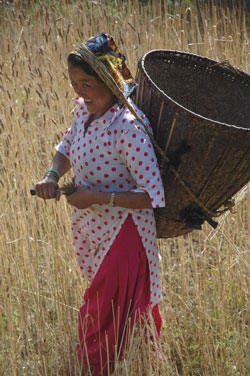 Trekkers living in tents find relief from boredom in tidying up and cooking, day in, day out. Those relying on guesthouses, have to find solace in food menus. Here, against the backdrop of the crystal pinnacles of Ama Dablam, Cho Oyu, Kantega and Thamserku,2 a restaurant menu obtains the significance of Holy Scripture: people go through them, again and again, recalling delicacies once had, and study its assortment that has by now been cemented in their memories.
"Come as a Guest, go as a Friend!" welcomes the first page enticing you into a whirlpool of culinary fads, such as Julius Cheeser, Pasta Carbonara, Yak Steak and Sneakers Momo. The whimsicality of their names and recipies, which could possibly be explained by the hallucinatory effect of mountain sickness, matches only those ordering them: a British failed smuggler, made bankrupt by his Sherpa wife; a bunch of Russians who, speaking no word of any foreign tongue, cordially teach a group of Nepalese how to play durak3; mountaineers, geologists, painters and writers; married couples who have sold their houses or cars in exchange for a tour around Asia; seekers of "not touristy" monasteries (they must be goofy as they look for them in the most touristy spots) and new adherents of Tibetology and Buddhism.
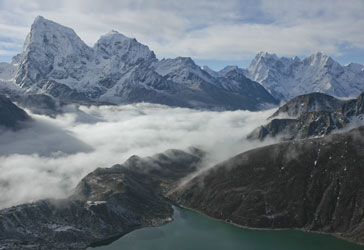 As evening draws nearer, books are brushed aside and the heated canteen fills up with heated conversations and arguments about what to visit next, if there aren't any Maoists in the mountains or whether Reinhold Messner, the greatest alpinist of them all, had climbed Everest without oxygen.
When the weary trekkers finally reach the sought-after heights with vantage points (twice a day, as if following a certain schedule), some parties branch out to climb further up, their cameras at the ready. After a couple of hours of monotonous ascent that nearly bursts your lungs due to the strain, you find yourself somewhat in the shoes of Hillary4, Messner and Mallory5 – all rolled into one! But the clouds above remain silent, untouched by the sentiments, and there is no guarantee that you will catch daybreak rising on an 8,000-metre peak. "It's the mountains. Everything here is a matter of luck", a guesthouse hostess consoles me after I had stepped into the fog and stayed there for two hours, trying to pierce the clammy misty rags. There was no view after half an hour or after one hour. I drowned my despair in litres of ginger tea, nodding in agreement with the hostess' reassurance to hurry up and try my luck again in a second quick march.
In such an environment, which reminds me of the movie Groundhog Day, there is always another chance, followed by many others. This is what the mountaineers getting ready for an ascent really enjoy. I was told that it's actually fun and, with each day, it gets easier to climb. Then, one beautiful day, which may even be tomorrow, you'll finally get lucky and be there right in time to catch the clouds wrapping the peaks suddenly disperse, allowing you to take the pho- to of your dreams. It could be the mo- ment that you decide to call it a day. But something tells me that as soon as tomorrow comes, I might run into you again, half-way to Everest – "Because it is there!"6
Text and photo by Olga Kovalenko
1 A standard greeting in Indian and Nepal, translated from Sanskrit as "The light in me welcomes the light in you"
2 Pinnacles of 7,000 to 8,000 metres high in the vicinity of Everest.
3 A card game that is popular throughout most of the post-Soviet states. The objective of the game is to get rid of all of one's cards. At the end of the game, the last player still holding cards in their hands is referred to as the fool (durak).
4 Edmund Hillary, together with the Sherpa Tenzing Norgay, were the first to conquer Everest (in the New Zealand expedition of 1953).
5 George Mallory could have been the first to climb to the peak of Everest, but this is not a proven fact, as neither he nor his fellow climber, Andrew Irvine, came back alive.
6 Mallory, who was obsessed with the idea of con- quering Everest, gave this answer to a journal- ist's question of "Why did you want to climb this mountain?"
|
|
 +65 6696 7068
+65 6696 7068
 info@meridian103.com
info@meridian103.com
 PDA
PDA
 +65 6696 7068
+65 6696 7068
 info@meridian103.com
info@meridian103.com
 PDA
PDA

Good day, I would like to bring this to the notice of the public about how i met Funding Circle Loan PLC after i lost my job and been denied loan by my bank and other financial institution due to my credit score. I could not pay my children's fees. I was behind on bills about to be thrown out of the house due to my inability to pay my rent, It was during this period my kids were taken from me by foster care. Then i set out to seek for funds online where i lost $3,670 that i borrowed from friends which i was rip off by two companies. Until i was referred to Funding Circle Plc by a very good friend, so if truly you are in need of a loan i advise you contact this Godsent lender via Email: fundingcapitalplc@gmail.com OR Call/Text +14067326622 and be free from scam' Jennie Cortez by name from United State
Jennie Cortez, 2017-11-23